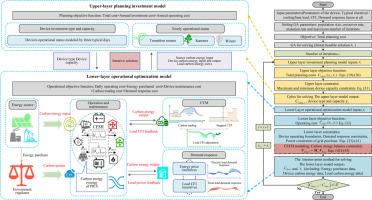A two-layer low-carbon economic planning method for park-level integrated energy systems with carbon-energy synergistic hub
IF 9.6
Q1 COMPUTER SCIENCE, ARTIFICIAL INTELLIGENCE
引用次数: 0
Abstract
Building a low-carbon park is crucial for achieving the carbon neutrality goals. However, most research on low-carbon economic planning methods for park-level integrated energy systems (PIES) has focused on multi-energy flow interactions, neglecting the “carbon perspective” and the impact of the dynamic coupling characteristics between multi-energy flows and carbon emission flow (CEF) on carbon reduction and planning schemes. Therefore, this paper proposes a two-layer low-carbon economic planning method for park-level integrated energy systems with carbon-energy synergistic hub (CESH). Firstly, this paper establishes a CESH model for PIES to describe the synergistic relationship between CEF and multi-energy flows from input, conversion, storage, to output. Secondly, a PIES two-layer low-carbon economic planning model with CESH is proposed. The upper model determines the optimal device types and capacities during the planning cycle. The lower model employs the CESH model to promote carbon energy friendly interactions, optimize the daily operation scheme of PIES. The iterative process between the two layers, initiated by a genetic algorithm (GA), ensures the speed and accuracy. Finally, case studies show that, compared to planning methods without the CESH model, the proposed method is effective in reducing carbon emissions and total costs during the planning cycle. From a dual “carbon-energy” perspective, it enhances investment effectiveness and carbon reduction sensitivity by deeply exploring the energy conservation and carbon reduction potential of PIES.

具有碳-能协同枢纽的园区级综合能源系统的双层低碳经济规划方法
建设低碳园区对于实现碳中和目标至关重要。然而,关于园区级综合能源系统(PIES)低碳经济规划方法的研究大多集中在多能源流的相互作用上,忽视了 "碳视角 "以及多能源流与碳排放流(CEF)之间的动态耦合特性对碳减排和规划方案的影响。因此,本文提出了碳能协同枢纽(CESH)的园区级综合能源系统双层低碳经济规划方法。首先,本文建立了 PIES 的 CESH 模型,以描述 CEF 与多能源流之间从输入、转换、存储到输出的协同关系。其次,本文提出了具有 CESH 的 PIES 双层低碳经济规划模型。上层模型确定规划周期内的最佳设备类型和容量。下层模型利用 CESH 模型促进碳能源友好互动,优化 PIES 的日常运行方案。两层模型之间的迭代过程由遗传算法(GA)启动,确保了速度和准确性。最后,案例研究表明,与不使用 CESH 模型的规划方法相比,所提出的方法能有效减少规划周期内的碳排放量和总成本。从 "碳-能 "双重角度来看,该方法通过深入挖掘 PIES 的节能和减碳潜力,提高了投资效益和减碳敏感性。
本文章由计算机程序翻译,如有差异,请以英文原文为准。
求助全文
约1分钟内获得全文
求助全文
来源期刊

Energy and AI
Engineering-Engineering (miscellaneous)
CiteScore
16.50
自引率
0.00%
发文量
64
审稿时长
56 days
 求助内容:
求助内容: 应助结果提醒方式:
应助结果提醒方式:


